Phaulopsis imbricata
Phaulopsis imbricata (Forssk.) Sweet
Family: Acanthaceae
Common names: sticky acanth (Eng.); umhlonyane (isiZulu); papleaf (The Gambia), salt of the cow (Senegal)
Introduction
Phaulopsis imbricata is a bushy, perennial herbaceous plant, with small white flowers in short spikes that are sticky to the touch. Easy to grow, it is an ornamental groundcover in semi-shade that can be used as a fodder plant and in traditional medicine and young leaves can be eaten as a vegetable.
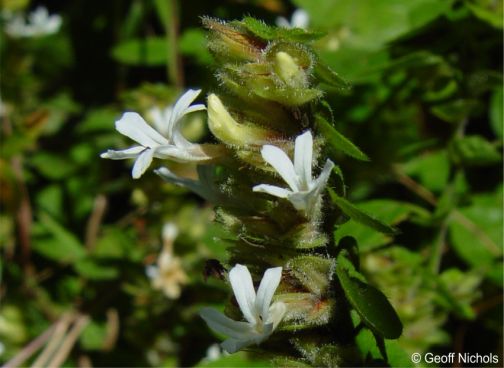
Description
Description
Phaulopsis imbricata is a trailing or scrambling herbaceous perennial about 1 m in height, generally branching from the base, with stems that at first grow flat on the ground and then become vertical. Young stems are sub-quadrangular, eventually becoming rounded at maturity, green to brownish-green, about 2 mm thick, and covered with soft white hairs. This plant has pairs of opposite leaves, one leaf is larger than the other, and they are mostly asymmetric at the base, dark green on the upper surface and slightly paler on the lower surface, and covered with soft hairs.

The inflorescence consists of terminal clusters of tiny, pretty white flowers, with 5 calyx lobes and broad, overlapping bracts at the base. Flowering is in late summer, autumn and early winter (from February to July). The flowers have an unpleasant smell, reminiscent of a mature ram. The fruit is a capsule, 8-9 mm long with 2 locules producing 2 seeds each, exploding when ripe.
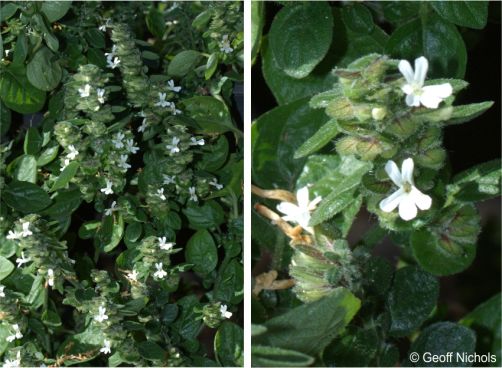
Conservation Status
Status
Phaulopsis imbricata is assessed as Least Concern (LC) on the Red List of South African Plants.
Distribution and habitat
Distribution description
Phaulopsis imbricata occurs in tropical and southern Africa, Comoros, Madagascar, Réunion and the Arabian Peninsula. In South Africa it occurs in Eastern Cape, KwaZulu-Natal, Mpumalanga and Limpopo shady areas, as undergrowth in forests, on forest margins, in woodland, scrub, kloofs and on hillsides. It can also climb into trees if they are close by.

Derivation of name and historical aspects
History
The genus name is derived from Greek, phaulos, meaning ‘slight’ or ‘trivial’, and opsis, meaning ‘appearance’, possibly referring to the small flowers. The species name imbricata is a Latin word meaning ‘overlapping in a regular order’, in this species it refers to the overlapping of bracts. It is sometimes commonly called Himalayan ruellia, which is a misnomer because it doesn’t occur in the Himalayan region and this name name applies to Phaulopsis dorsiflora.
The family Acanthaceae consists of terrestrial or aquatic herbs, shrubs and rarely trees. The family is usually distinguished by opposite and simple leaves, the flowers are bisexual, symmetric, often have coloured bracts.
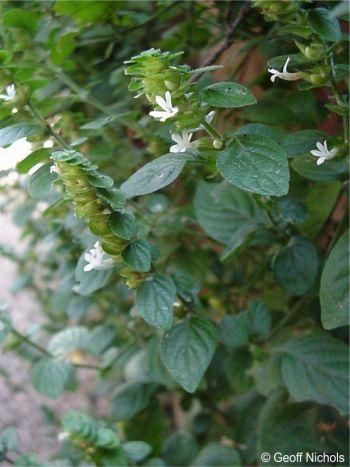
Ecology
Ecology
Phaulopsis imbricata is one of the larval host plants for several species of butterfly, such as great egg fly, tiny grass blue, brown pansy, soldier pansy and marbled elf. The flowers are visited by bees.
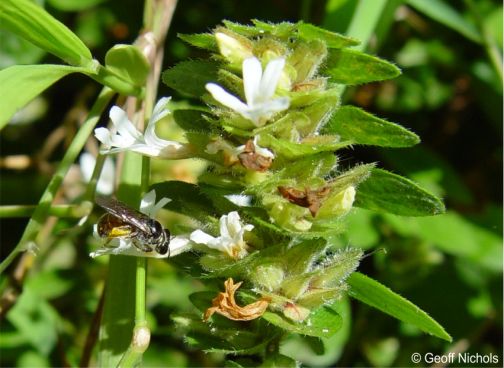
Uses
Use
The plant is commonly grazed by livestock in Kenya, and in Sengal and The Gambia judging by the Diola name for it, ‘salt of the cow’, which implies that the grazers benefit from some mineral intake. Immature leaves are eaten as a vegetable in certain African countries. The powdered roots are used to treat sores, leaf sap is taken for diarrhea, stomachache and nausea. Hot fomentations of the leaves are used to treat fever. Plant-ash is used to treat rheumatism, and rubbed on the temples for headache as an analgesic (painkiller).
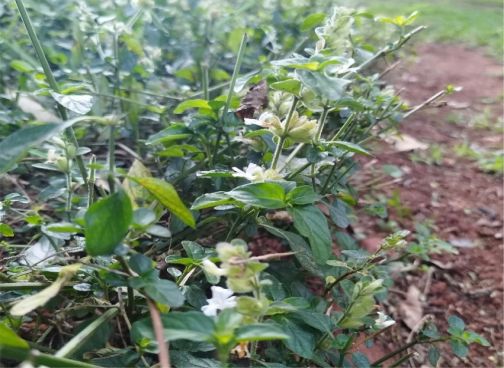
Growing Phaulopsis imbricata
Grow
This plant is easy to grow in almost any soil. Tip cuttings taken from actively growing plants root readily in 10-14 days under mist with bottom heat, and roots can easily shoot from lower nodes when they get attached to the soil. It can also be propagated by seeds. Grow Phaulopsis imbricata in warm climates, in well-drained, fertile soil, in semi-shade or bright, indirect sunlight, with regular water in summer but do not allow it to become waterlogged. Prune to shape and keep in check.
References
- Burkill, H.M. 1985. The useful plants of west tropical Africa, 2nd edition. Vol. 1: Families A–D. Royal Botanic Gardens, Kew.
- Global Biodiversity Information Facility (GBIF). Phaulopsis imbricata (Forssk.) Sweet. https://www.gbif.org/species/7501398. Accessed on 12/09/2023.
- Kamundi, D.A. 2006. Phaulopsis imbricata (Forssk.) Sweet subsp. imbricata. National Assessment: Red List of South African Plants version 2020.1. Accessed on 02/09/2023.
- Mziray, W. 1992. Taxonomic studies in Toddalieae Hook. F. (Rutaceae) in Africa. Symbolae Botanicae Upsaliensis 30-31: 126-128.
- Nichols, G. 2005. Growing rare plants: a practical handbook on propagating the threatened plants of southern Africa. Southern African Botanical Diversity Network Report No. 36.
- Plants of the World Online, Phaulopsis imbricata (Forssk.) Sweet. https://powo.science.kew.org/taxon/urn:lsid:ipni.org:names:53010-1. Accessed 4 Oct. 23.
- Pooley, E. 1998. A field guide to wild flowers Kwazulu-Natal and the eastern region. Natal Flora Publications Trust, Durban.
- Wikipedia, Phaulopsis imbricata. https://en.wikipedia.org/wiki/Phaulopsis_imbricata. Accessed on 11/09/2023.
- World Flora Online. Phaulopsis imbricata Sweet. https://www.worldfloraonline.org/taxon/wfo-0000393137 . Accessed on 11/09/2023.
Credits
Bongekile Ndlovu
Pretoria National Botanical Garden
October 2023
Acknowledgements: thanks to Geoff Nichols for images as credited.
Plant Attributes:
Plant Type: Ground Cover, Perennial, Scrambler
SA Distribution: Eastern Cape, KwaZulu-Natal, Limpopo, Mpumalanga
Soil type: Sandy, Loam
Flowering season: Late Summer, Autumn, Winter
PH: Acid, Alkaline, Neutral
Flower colour: White
Aspect: Morning Sun (Semi Shade), Afternoon Sun (Semi Shade)
Gardening skill: Easy
Special Features:
Horticultural zones








Rate this article
Article well written and informative
Rate this plant
Is this an interesting plant?
Login to add your Comment
Back to topNot registered yet? Click here to register.